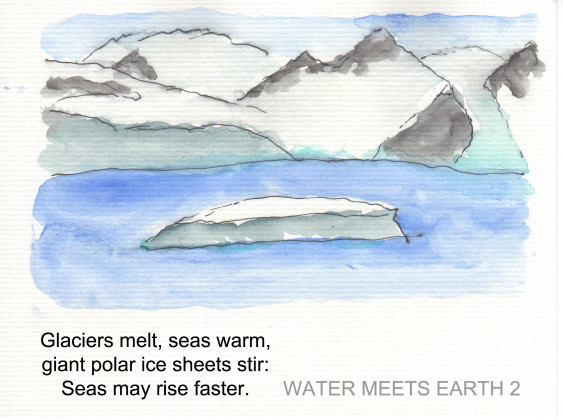From 6-17 November the 23rd Session of the Conference of Parties (COP23) is taking place in Bonn under the presidency of Fiji. Ahead of the second week of the Climate Conference we have a creative challenge for you. Today is Oceans Action Day and we’re launching a #COP23Haiku jam inspired by Gregory S. Johnson’s climate change haikus.
The Haiku Jam is part of an arts & storytelling in the spirit of the Pacific “Talanoa” approach to storytelling and the overall #Uniting4Climate conference theme.
We like to challenge you to convey a vivid call to climate action in your language (if possible with English translation) in only 17 syllables.
Johnson, a Seattle-based oceanographer, used haiku four years ago to condense the results and recommendations of the 2013 Fifth Assessment IPCC report. The Intergovernmental Panel on Climate Change (IPCC) is the international body for assessing the science related to climate change.
Such a 2,200-page report is not an easy reading, not even for a climate scientist and co-author. Johnson was a lead author on the chapter about marine measurements. One day, while being home sick, Johnson went over the report’s 28-page summary for policymakers.
“I thought that distilling these ideas into haiku could help me fix them in my mind,” he says. So he created 19 haikus and paired them with water-color pictures. The Entire IPCC Report in 19 Illustrated Haiku
A haiku is a very short poem following more or less the style of the Japanese haiku poetry. Haikus have been around since the 9th century. They are like tiny windows into something much larger, often inspired by nature, a moment of beauty, or poignant experience.
Traditionally a haiku is written in three lines with a 5 / 7 / 5 syllable count. This page explains how to write a haiku poem. Here is an example of the Japanese poet Matsuo Bashō (1644–1694), translated by Donald Keene.
The passing of spring— (5 syllables)
The birds weep and in the eyes (7 syllabes)
Of fish there are tears. (5 syllables)
Haikus are popular in the social media sphere because their elliptical syntax with no superfluous words works well with the 140-character constraint of a tweet.
Johnson enjoys haiku as a form of expression and mediation and posts almost exclusively in haiku on Facebook. “I never intended to publish these climate haikus, but some friends and colleagues urged me to share the booklet with the public,” he says.
Eventually, he allowed the Sightline Institute , a Seattle-based environmental think-tank, to post his climate haiku collection on its website. The virtual booklet went viral afterwards. Johnson emphasized that the work was solely his own creation and did not represent the U.S. government, IPCC or any other entity.
Johnson became a celebrity in the Twitterphere and praised in the media for coming up with a simple, elegant way to communicate complex scientific findings and climate change.
Like Johnson, we’d like you to share with us something about your personal thoughts about climate change or hopes for the COP23, a three line Haiku poem with 5, 7 and 5 syllables. The lines don’t even have to rhyme.
Ahead of the COP23, we contacted Johnson to ask for his permission to use his climate haikus for outreach and educational purposes. We displayed his artwork at the GreenDrinks COP23 GreenDrinks Arts & Music Extravaganza on the opening day of the climate summit.
We’ll be presenting the best COP23 haikus on November 17th at the Fiesta Viktoria and on the Bonnections Blog. So please send us your climate poems or prayers – along with a bit about yourself (name, age, country). You can post your haiku on our Facebook page or tweet them with the hashtag #COP23Haiku. Our email address is bonnections@gmail.com.





